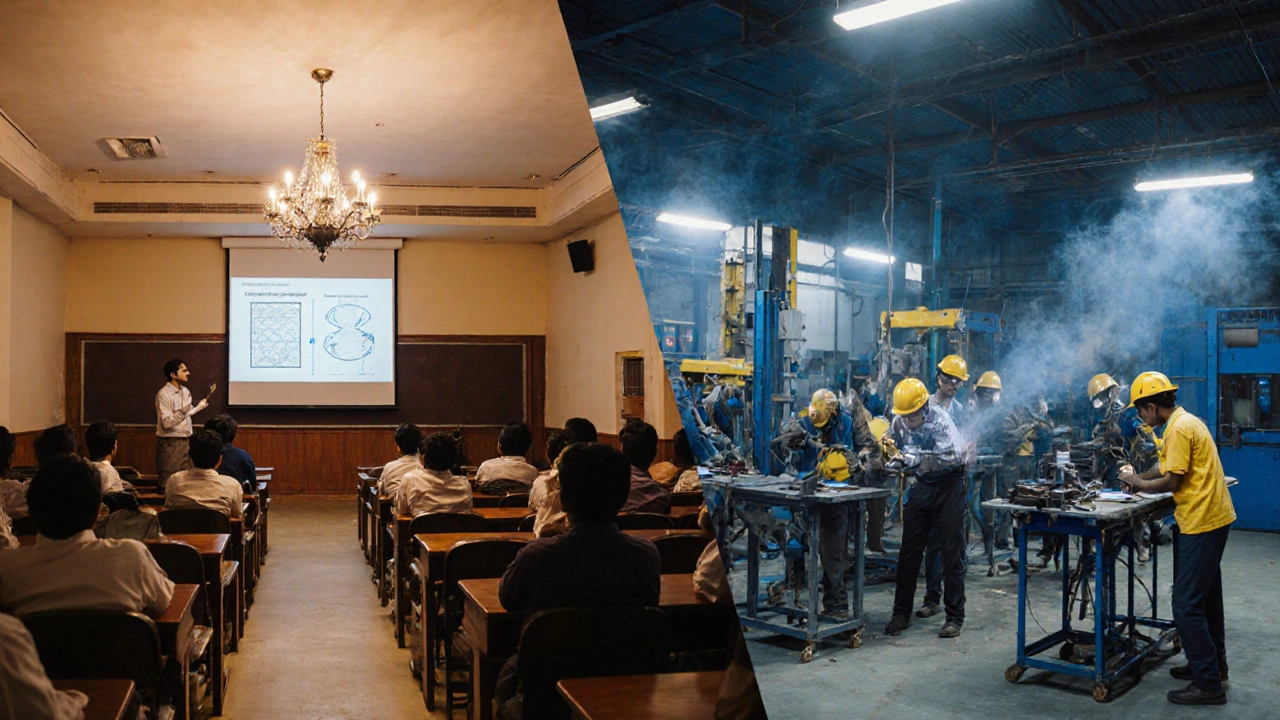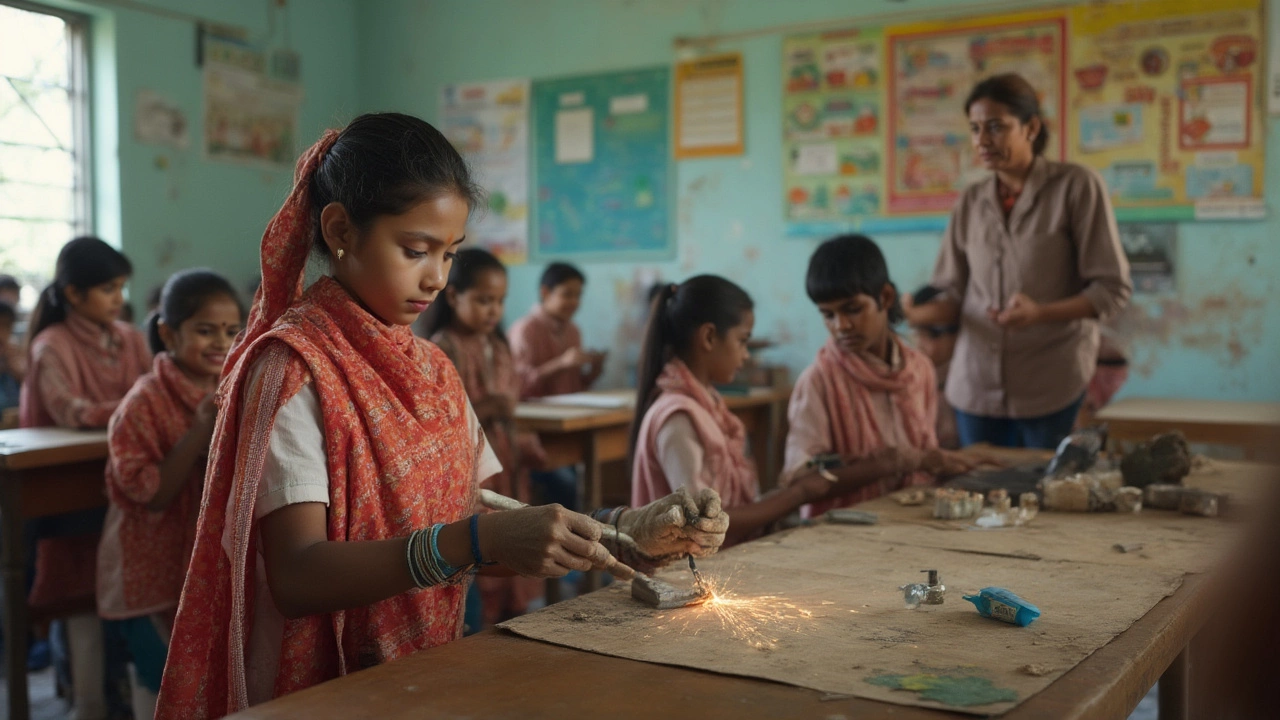Career Path Cost & Time Calculator
Vocational Path
General Education Path
Vocational Education
General Education
Key Insights
Vocational paths typically require 50-70% less financial investment and provide 6-12 months faster job readiness compared to general education. Consider your career goals and time constraints carefully.
When you hear people talk about "education" they often picture classrooms, exams, and degrees. But not all education follows the same route. Understanding the split between vocational education and general education helps you pick the path that matches your career goals, learning style, and financial situation.
What Is Vocational Education?
Vocational Education is a skill‑focused learning system that prepares students for specific trades or occupations through hands‑on training, apprenticeships, and industry‑linked curricula. It typically leads to a certificate, diploma, or associate‑level qualification rather than a four‑year degree.
In India, bodies like the National Skills Qualification Framework (NSQF) and institutions such as Industrial Training Institutes (ITIs) deliver these programs. Courses range from electrician and automotive mechanics to graphic design and data analytics.
What Is General Education?
General Education refers to the traditional academic pathway offered by schools, colleges, and universities. It emphasizes a broad knowledge base-humanities, sciences, mathematics-and culminates in a bachelor's, master's, or doctoral degree.
This model prepares learners for a wide array of professions, research roles, or further study, often requiring more theoretical work and longer study periods.
Core Structural Differences
- Duration: Vocational programs usually span 6 months to 2 years; general degree programs run 3-4 years for a bachelor’s degree.
- Curriculum Design: Vocational curricula are built around specific job competencies, while general curricula balance core subjects with electives.
- Assessment Style: Practical exams, projects, and on‑the‑job evaluations dominate vocational assessment; general education relies heavily on written exams and research papers.
- Entry Requirements: Vocational courses often accept students after 10th grade or with a minimal pass in a relevant subject; general education typically requires completion of 12th grade (or equivalent) and entrance exams.
Learning Outcomes & Skills
Vocational training hones "hard" skills-welding, coding, culinary techniques-directly transferable to the workplace. Soft skills like teamwork and time management are embedded through real‑world projects.
General education cultivates analytical thinking, research methodology, and broad‑sense communication. While you can learn technical abilities, they often require supplementary courses or self‑study.

Pathways & Career Opportunities
Graduates of vocational programs can step straight into roles such as electrician, medical lab technician, or graphic designer. Many employers value the immediate productivity of a vocational graduate.
General education graduates may start as analysts, teachers, or engineers, but they often need additional certifications or on‑the‑job training for specialized positions.
Admission & Eligibility Details
Below are typical entry points for each stream:
- Technical Institute admission (vocational) usually requires a 10th‑grade pass, followed by a merit‑based entrance test or direct enrollment.
- University admission (general) is based on 12th‑grade marks, national entrance exams (e.g., JEE, NEET), and sometimes interviews.
Pros & Cons of Each Approach
| Aspect | Vocational Education | General Education |
|---|---|---|
| Time to complete | 6 months - 2 years | 3 - 4 years (bachelor’s) |
| Cost | Generally lower tuition, often subsidized by government schemes | Higher tuition, especially in private universities |
| Job readiness | High - skills matched to industry needs | Medium - may require further training |
| Career progression | Can lead to rapid entry‑level roles, but ceiling may be lower without further study | Broader scope for research, leadership, and academic careers |
| Flexibility | Focused on one trade; less interdisciplinary exposure | Offers electives and interdisciplinary majors |

Choosing the Right Path for You
Ask yourself these three questions:
- What are my career goals? If you want to become a certified electrician within a year, vocational training is the fastest route.
- How do I learn best? Hands‑on learners thrive in vocational settings; readers and theorists may prefer the lecture‑based approach of general education.
- What resources can I invest? Consider tuition, time, and opportunity cost. Vocational courses often require less financial outlay.
Many students blend both worlds: start with a vocational diploma, then later pursue a bachelor’s degree to broaden opportunities. The Indian government encourages this through bridge programs that credit prior vocational learning toward a university degree.
Future Trends Shaping Both Streams
Digital transformation is blurring the lines. Online platforms now host accredited vocational courses, while universities embed micro‑credentials and industry projects into their curricula. Emerging fields like data science, renewable energy, and cybersecurity are offered as short, skill‑based modules alongside traditional degree programs.
Keeping an eye on the National Skills Qualification Framework (NSQF) levels helps you track how a vocational certificate can stack up to a university degree over time.
Final Thoughts
Neither vocational nor general education is inherently superior. The best choice aligns with your personal goals, learning preferences, and the evolving demands of the job market. Use the comparison table, weigh the pros and cons, and map out a pathway that lets you acquire the skills you need-whether that’s a trade certification tomorrow or a bachelor's degree in five years.
Frequently Asked Questions
Can I switch from a vocational program to a university degree later?
Yes. Many Indian universities accept vocational diplomas for lateral entry, especially if the course aligns with the degree’s major. You may need to bridge some academic gaps, but credit transfers are increasingly common.
Which option offers better salary prospects right after completion?
Vocational graduates in high-demand trades (e.g., electricians, CNC operators, cloud technicians) often earn comparable or higher starting salaries than fresh university graduates, because employers value immediate competence.
Do vocational courses have internships?
Most vocational programs incorporate industry placements or apprenticeships lasting 3-6 months, providing on‑the‑job experience before certification.
Is general education still relevant in the age of automation?
Absolutely. Critical thinking, research skills, and interdisciplinary knowledge-core outcomes of general education-help professionals adapt, innovate, and lead in automated environments.
What financing options exist for vocational training?
Many state governments offer subsidies, skill‑development loans, and the Pradhan Mantri Kaushal Vikas Yojana (PMKVY) covers fees for eligible candidates. Private banks also provide low‑interest education loans for vocational courses.

